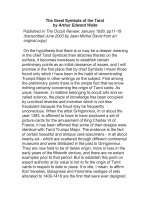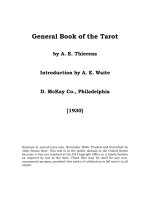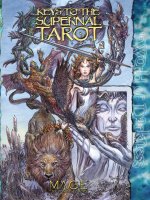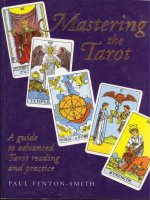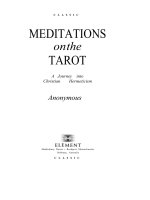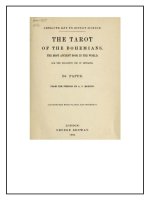Hướng dẫn bói bài Tarot The tarot the origins, meaning and uses of the cards
Bạn đang xem bản rút gọn của tài liệu. Xem và tải ngay bản đầy đủ của tài liệu tại đây (3.71 MB, 263 trang )
Alfred Douglas
THE TAROT
THE TAROT
Alfred Douglas was born in England in 1942. Inspired by his
family's interest in arcane tradition, he began to srudy occult
symbolism when he was stili very voung. His attraction to
orienta! behefs and practices lcd to his first full-length work,
How to Ccrnsult the I Cning, published in 1971. Later in 1976
his book entitled Extra Sensory Powers: A Cenrury of Psychical Research was published. He is a member of the College
of Psychic Studies and of the celebra-Led Sociery for Psychical
Research, the oldest organization of its kind in the world. A
regular contributor to the journal Prediction and a frequent
guest on British radio and television, Douglas lives in North
London with his family.
On the next page
The twenty-two cards of the Tarot major trumps arranged in a figureof-eight. (Drawings by David Sheridan.)
BY THE SAME AUTHOR:
THE ORACLE OF CHANGE
How to Consult the I Ching
ARKANA
Published by the Penguin Group
Penguin Books Ltd, 27 Wrights Lane, London W8 5TZ, England
Penguin Books USA Inc., 375 Hudson Street, New York, New York 10014, USA
Penguin Books Australia Ltd, Ringwood. Vittoria, Australia
Penguin Books Canada Ltd, 10 Akorn Avenue, Toronto, Ontario, Canada M4V 3B2
Penguin Books (N2) Ltd, 182-190 Wairau Road, Auckland 10, New Zealand
Penguin Books Ltd, Registered Oftices: Harmondsworth, Middlesex, England
First published in the United State& of America by Taplinger Publishing Co., Inc., 1972
First published in Great Britain by Victor Gollanc2 Ltd 1973
Published in Penguiu Books in the United States of America 1973
Published in Penguin Books in Great Britain 1974
Published by Arkana 1991
3 5 7 91086 4 2
Copyr
Alfred Douglas, 1972
Otgiaald~ copyríght C David Sheridan, 1972
AIl rights reserved
Printed in England by Clays Ltd, St Pres pie
T!:peset in Manti('
Except in del:~ Suits o America, Mia bank is sold subject
to the condidoet tiri ie sim1E noi, b5 was ai trade or otherwise, he lent,
re-sold, hired 01IL a- °d'emise curralated without the publisher's
prior consent :n any forni of binding or nover other than that in
wIneb it is pabbsbed and Nbitbou" a similar oondtIon incl.aing 'bis
condition ben imposed on the subsequent purebascr
ALFRED DOUGLAS
The Tarot
THE ORIGINS, MEANING AND
USES ❑ F THE CARDS
Illustrated by David Sheridan
ARKANA
To
my old friend
MADELINE MONTALBAN
who introduced me to
the Tarot
ACKNOWLEDGEMENTS
Grateful acknowledgement is herewith made to the following
publishers far their kind permission to quote from tities published
by them:
To George Allen & Unwin Ltd., publishers of Schopenhauer's
Essays translated by Thomas Bailey Saunders.
To Rider and Company, publishers of Trauscendental Magic and
A Histwy of Magic by Eliphas Lévi, and The Tarot of the Bohemians
by Papus.
To Routiedge & Kegan Paul Ltd. and to Princeton University
Press, publishers of The Strutture and E)ynamics of the Psyche and
Psychology and Alchemy, volumes 8 and 12 of the collected works
of C. G. Jung, edited by G. Adler, M. Fordham, H. Read, translated by R. F. C. Hull (Bollingen series XX); and Aurora Consurgens, edited by Marie-Louise von Franz, translated by R. F. C.
Hull and A. S. B. Glover (Bollingen series LXXVII).
Thanks are also due to the Trustees of the British Museum for
their courtesy in allowing the reproduction of itoms in their
collection of playing cards.
The author would also like to record his appreciation of the
help extended to him during his researches by Professar Mario
Tassorti and Miss Liana Borghi of the Italian Institute, London;
and to Mr Adriano Lombardini of Bergamo, Italy, for permission
to reproduce cards from the Masenghini Tarocco pack.
The Tarot designs reproduced 011 pages 28-29 were photographed by John Freernan; alt the other photographs are the work
of Barry Rolfe.
7
CONTENTS
Page
13
Freface What are Tarot cards?
Chapter
The origin of Tarot cards
The symbolism of the Tarot
The Medieval Renaissance
Gnostic influences on Medieval thought
The Gnostic theme of the major trumps
The varied sources of Tarot imagery
The Art of Memory
The gamé of Triumphs
The minor cards of the Tarot pack
The four Gran Hallows
The Four Treasures of Ireland
19
26
3
The meaning of the major trumpa
39
4
The major arcana
The Fool
I The Magician
II The Papess
III The Empress
IV The Emperor
V The Pope
VI The Lovers
VII The Chariot
VIII justice
IX The Hermit
X The Wheel of Fortune
46
47
so
53
57
6o
63
66
69
2
9
26
30
32
33
34
35
35
36
37
72
75
78
XI Fortitude
XII The Hanged Man
XIII Death
XIV Temperance
XV The Devil
XVI The Tower
XVII The Star
XVIII The Moon
XIX The Sun
XX Judgement
XXI The World
The Fool
Page
82
85
89
92
95
99
102
105
108
III
113
I16
5
The Esoteric Tarot
I18
6
The Esoteric Tarot: The minor arcana
The court cards
The small cards
131
131
133
7
Divinatory meanings of the minor arcana
The court cards: Batons
The court cards: Cups
The court cards: Swords
The court cards: Coins
The forty small cards
The Suit of Batons
The Suit of Cups
The Suit of Swords
The Suit of Coins
135
136
142
148
153
159
160
170
180
190
8
How to consult the Tarot
Is there anyrhing in it?
How to begin
Commencing a reading
The Nine Card spread
The Circular spread
The Horseshoe spread
201
Io
201
202
203
204
208
210
9
Meditation and the Tarot
Descriptions of the major trumps
Io The game of Tarocco
The Piedmontese Code
A typical game
Appendix Where you can obtain Tarot cards
Notes
Babliography
Index
II
Page
213
218
226
227
230
235
237
243
247
Preface
WHAT ARE TAROT CARDS?
TAROT CARDS ARE probably the originai European playing
cards, the forerunners of our modula pack; but the standard
Tarot pack differs from its more familiar descendent in several
ways.
For example, it is made up of a total of seventy-eight cards
instead of only fifty-two. Also, it is really two packs combined—a
fifty-six card pack called the lesser arcana or mali cards, and a
twenty-two card pack called the greater arcana or Tarot trumps.
The lesser arcana of the Tarot is the source of present-day
playing cards. The fifty-six cards are divided into four suits
in Italian, Bastoni (Batons or Clubs), Coppes (Cups), Spade
(Swords), and Denari (Coins). Each suit is made up of ten cards
numbered from Ace (i) to io, with the addition of four court
cards called the Re (King), Dama (Queen), Cavallo (Knight) and
Fante (Knave or Jack).
English and American playing cards of today show French suitmarks which first carne into use in the early isth century. These
are called Trffies (Trefoils), Coeurs (Hearts), Piques (Pikes), and
Carreaux (Paving Tiles); equivalent to the English Clubs, Hearts,
Spades and Diamonds. Curiously enough, the names of three of
the English suits are derived from the Italian Tarot: Spades from
the Italian Spade, Clubs from Bastoni, and Diamonds from
Denari. Only the suit of Hearts takes its rame from the French
cards.
The remaining part of the Tarot, the twenty-two card greater
arcana, is now only used in certain parts of the world. Only one of
its cards has affected the transition to the fifty-two card pack. The
trump card entitled The Fool has survived as the Joker.
Each card of the greater arcana depicts a symbolical figure or
scene and has a descriptive tale printed at the bottom of it. The
13
cards are numbered, in Roman numerals, from I to XXI, only
The Fool having no nuinber assigned to it.
Prior to about 1750 ali Tarot trumps seem to have been named
in Italian, but most tater packs give the titles in French. The word
"Tarot" comes from the French cards. In Italy they are called
Tarocchi. The origin and meaning of this word is not known.
Here are the titles of the twenty-two major trump cards in
Italian, French and English, given in their usual order:
Il Matto
I
Il Bagattel
Il
La Papessa
L'imperatrice
L'Imperator
Il Papa
Gli Amanti
ll Carro
La Giustizia
L'Eremita
III
IV
V
VI
VII
VIII
IX
Le Fou (or Le Mat)
Le Bateleur
La Papesse
L'Impératrice
L'Empereur
Le Pape
L'Amoureux
Le Chariot
La Justice
L'Ermite (or Le
Capuchin)
Ruota della Fortuna
Roue de Fortune
La Forza
La Force
L'Apesso
Le Pendu
(or Lo Iropiehato)
XIII
La Morte (or unnamed) (Unnamed)
La Temperanza
XIV
Temperance
XV
Il Diavolo
Le Diable
XVI
La Torre
La Maison de Dieu
XVII Le Stelle
L'Etoile
XVIII La Luna
La Lune
XIX
Il Sole
Le Soleil
XX
Il Gindizio
Le Jugement
(or L'Angelo)
II Mondo
XXI
Le Monde
X
XI
XII
The Fool
The Magician
The Female Pepe
The Empress
The Emperor
The Pope
The Lover(s)
The Chariot
Justice
The Hermit
Wheel of Fortune
Fortitude
The Hanged Man
Death
Temperante
The Devil
The Tower
The Star
The Moon
The Sun
judgement
The World
Despite the popularity of the lesa complicated fifty-two card
pack, Tarot cards have retained a loyal following in some parts of
Europe, and they are stili being manufactured today. You
will find the full seventy-eight card Tarot in use in Italy,
Czechoslovakia, France, Switzerland, Yugoslavia and parta of
North Africa.
Also, as a result of the current resurgence of interest in divination and other aspects of the occult, Tarot cards can be found on
sale in major cities in practically every country in the West.
Although the cards vere established in Italy, France and
Germany by the late 14th century, the time, piace and circumstances of their creation remains a mystery. The complex and
beautiful designs of the twenty-two greater arcana cards in
particular provide an enigma that has never been satisfactorily
resolved. Who made them and what are they meant to illustrate? _
Nobody knows for certain.
'5
THE TAROT
Chapter
THE ORIGIN
TAROT
CARDS
IT IS GENERALLY accepted by scholars that the earliest playing
cards originated in China ano Korea, where examples have been
found dating back to at least the rith century. The design of
these cards appears to have been based on paper money, which
evolved during the T'ang dynasty (618-908).
One must regretfully reject the solution offered by the Chinese
dictionary Ching-tze-tung of 1678 which rlaims that playing cards
were invented in 1120 for the amusement of the Emperor's
concubines.
Early packs of cards from Southern China frequently have four
suits, called Coins, Strings of Coins, Myriads of Strings, and Tens
of Myriads. It is feasible that such packs provided inspiration for
the first makers of European cards, having been brought back by
merchants returning from the East. But there is no evidence to
support this theory--although the idea of using paper money was
brought West from China at this time.
Western playing cards do not resemble their Eastern
counterparts closely, either in shape or design.
One old theory suggests that cards originated in India. The
four-armed Hindu diety Ardhanari, an androgynous figure combining the right hall of the god Siva with the left half of bis consort
Devi, is sometimes depicted holding a cup, a sceptre, a sword and
a ring. The monkey-god Hanuman is also at times shown holding
these same emblems, which bear a dose resemblance to the four
suit-signs of the Tarot pack: Cups, Batons, Swords and Coins.
Unfortunately there is no evidence to reveal how old these
symbols are or whether they ever appeared on Indian playing
cards, which are generally circular and bear little resembiance to
European cards .1
Western playing cards first appeared in India during the 16th
19
century, having been carried there by travellers from. Europe. We
must discount, alas, the legend that playing cards were invented
by the wife of a Maharajah, to distract him from bis infuriating
habit of pulling bis beard.
According to the Italian author Covelluzo, writing in 1480,
cards WC= introduced into Italy in 1379 from North Africa.
Covelluzo says: "Anno x379, fu recato in Viterbo el gioco delle carte,
che venne de Seracinia, e chiamisi tra loro naib" ("In the year 1379
the game of cards was brought into Viterbo from the country of
the Saracens, where it is called naib.")'
The Arabs might have brought playing cards with them to
Europe. Alter expanding across Africa and Asia they had first
attempted to cross the Mediterranean in the 7th century. They
entered Spain around 71o, penetrated France as far as Arles by
731, had conquered Sicily by 832 and set font on the Italian mainland around 842. Later, they were hired as mercenaries by the
Popes and feuding Italian princes.
In 1379 they formed part of the paid armies of the riva! Popes
Urban VI and Clement VII. According to Covelluzo the Saracons
called the game of cards naib; significantly, cards in Spain are
called naipes, and the Arabs asso occupied Southern Spain until
1492.
However, naipes may be derived from the Flemish word knaep,
meaning paper, as a lively sea-trade existed between Spain and
Flanders at this time. Another fact counting against Covelluzo's
theory is that there is no mention of playing cards in the Arabian
Nights, which would surely have described them if they had been
in common use among the Arabs.
Also, records attest that by 1379 cards were known in France,
Switzerland and as far north as l3elgium.
One widespread belief, stili popular today, is that the pack was
brought into Europe by fortune-telling Gypsies coming from
either Egypt or India. But the Gypsies did not appear in the West
in any numbers until the middle of the t5th century, a full
hundred years after the cards were known in every country from
Italy to Northern France. The Gypsies adopted them and did
much to spread them abroad, but they did not invent playing
cards.a
20
The invention of Tarot cards has also been attributed to the
Order of the Knights Templar, an ascetic military Order founded
c. 1188 by Hugh de Payens and eight fellow knights to protect
pilgrims and guard the routes to the Holy Lanci.
The Templars gained Papal approvai and were awarded
privileges such as immunity from taxes and secular jurisdiction.
Over the years they attained a position of great weaith and power
and thus made many enemies. Finally, at the beginning of the r4th
century, Philip IV of France brought the charge of heresy against
the Order. In 1307 Templars in France were arrested and their
property seized; many were tortured by the Inquisition into confessing heretical beliefs. The persecution quickly spread to ali
other countries where the Templars had property, and the Order
was finally eradicated in 1314 when its Grand Master, Jacques de
Molay, was burned at the stake whilst declaring his innocence.4
The charges laid against the Templars were both contradictory
and unproven. Their long years in the East may have laid them
open to Gnostic infiuences, but this has not been established.
There is no evidence to connect them with the Tarot cards, or to
suggest parallels between their beliefs and the Tarot images.
All the evidence suggests that although the idea of playing cards
may have been brought to the West from elsewhere, the designs
we are fa►niliar with originated inside Europe. The question iswhere?
Many commentators have tried to find a due hidden in the
meaning of the word "Tarot". Some have asserted that it is derived
from an ancient Egyptian word, Ta-roste, meaning "The royal
way". Others have asserted that it is an anagram of the Latin word
rota, meaning "a wheel"—the cards then symbolising the circle of
life from birth to death.
Stili others have derived it from Torah, Hebrew for "the law",
hoping to link the cards with the mystical system of the Qabalah
but forgetting that the Qabalah originated in Spain, a country
which has never known the Tarot major trumps.
Some have seen in it a corruption of the name Thoth, the ancient
Egyptian god of magie, so reaffirming the legend that the cards
were created in the initiation temples of the mysterious East.
Tarot is the narne given to the cards in France. In Italy they are
21
called "Tarocco" (plural Tarocchi,) and in other countries Taro,
Taroc, or Tarok. It is not known which of these, if any, is the
originai form.
If the four suits of the pack were derived from the cards of
China, then the court cards (said to be originally coat cards as they
depicted richly garbed figures) may have been taken from figures
used in the game of chess, which had reached Europe via India and
the Holy Land at the time of the First Crusade (1095-9).
The twenty-two allegorica! trump cards may not have formed
part of the originai pack. The earliest undisputed reference to
playing cards which we have, a detailed description of cards and
card games made by a German monk living in a Swiss monastery in
1377, makes no mention of these striking designs.5
However, the major trumps were certainly in existence in 1415,
when a beautifui hand-painted Tarot pack was created for the
young Duke of Milan, Filippo Maria Visconti.°
Cards are not mentioned in the works of Boccaccio (1313-75) or
Petrarch (1304-74), but the majority of the most celebrated later
packs were hand-painted for members of the great families of
Northern Italy, such as the Visconti, Este, and Sforza. It is also a
fact that unti! around 17513 all Tarot packs had Italian suit-marks.
After this date packs produced outside Italy generally had French
suits and different major trump designs.
It used to be believed that the oldest cards stili in existence were
French. Seventeen of these cards—sixteen of them major trumps
of the Tarot—are in the Bibliothèque Nationale at Paris.?
It was long thought that these beautiful hand-painted cards
formed part of the pack made in 1392 for Charles VI of France and
recorded in his treasurer's book of accounts for February of that
year. But there is no connection between this passage and the
seventeen cards in the Bibliothèque Nationale, and the artistic
style and details of dress shown in the cards places them later in
time than 1392.
If Tarot cards—as seems most likely—were devised originally
somewhere in Northern Italy it can be surmised that their makers
were perhaps inspired by orientai cards brought from the East by
merchants rerarning to the great trading pori of Venice. The
originai seventy-eight card Tarot pack is generally referred to in
22
Italy as the Venetian or Piedmontese Pack to differentiate it from
later offshoots such as the ninety-seven card Fiorentine minchiate
pack and the sixty-two card Bolognese pack.
It is even possibie that the cards were named after their piace of
origin. The North Italian plain is watered by the river Po, an
important tributary of which is the river Taro.
Most of the historical evidenoe we have regarding the first
appearance of playing cards in Europe is of a negative kind.
Reference to town records can teli us when they became widespread enough to be worthy of note or condemnation, but not how
long it took for them te become popular or where they carne from.
Here is a summary of the known references to cards in the i4th
century and later. Some earlier mentions are claimed, but these
are all disputed.
Games are mentioned in the Townbook of Augsburg,
Germany, but cards are not referred te.
1289-99 The Code of Nuremberg, Germany, does not include
cards amongst its list of prohibited games.
1328-41 A French manuscript, "Renard le Contrefait", written
between these dates, contains a passage that might refer
te cards.
Cards and card games are described by a monk at the
1377
monastery of Brefeld, Switzerland.
Cards are banned in Regensburg, Germany.
1378
The purchase of cards is recorded in the accounts of the
1379
Dukedom of Brabant (Belgium).
138o-84 Cards are permitted by the Code of Nuremberg.
Cards are condemned in the records of a notary of
1381
Marseilles, France.
The treasurer's accounts of Charles VI of France
1392
includes a payment for three packs of hantim de cards.
Cards are listed amongst the permitted games in
1393
Florence.
A
decree in Paris includes cards amongst a list of games
1 397
forbidden to comrnoners on working days.
Tarot cards are painted for the Duke of
1415
Cards are ccaldetnned in a speech made at Bologna by
1423
1275
23
St Bernardin of Siena. He does not refer to the Tarot
major trumps.
1423-77 Townbooks of Nuremberg name several women as
card-painters.
1427
Two Master Card-makers are named in the Guild
registers of Brabant.
The earliest surviving cards printed from wood-blocks
144o
—they are French court cards.
Playing cards are printed at Stuttgart.
1440
The importation of foreign playing cards is prohibited
1441
by the authorities of Venice.
1450-70 A Franciscan Friar preaches a sermon in Northern
Italy condemning dice and cards. He makes a clear distinetion between the four suits and the twenty-two
major trumps.
The importation of foreign cards into England is far1463
bidden in a statute of Edward IV, to protect home
manufacturers.
It can be seen from the above table that the invention of woodblock printing in Germany in the early 15th century heralded the
start of a large-scale card manufacturing industry. The fact that
cards were banned in Regensburg as early as 1378 implies that
cheap stencilled packs were being produced in quantities at an
earlier date, as ordinary people could not possibly afford to purchase the sort of hand-painted packs which were supplied to the
nobility.
Popular demand for cards far outweighed religious opposition to
them, and by the mid-15th century card-making workshops were
thriving in many cities of Italy, France, Germany and Belgium.
Considering the variety of new games and new cards te play them
with which developed from this time onwards, it is remarkable
that the early designs survived at all.
There is a strong possibility that the twenty-two Tarot trumps
evolved independently of the four suits. They are not mentioned
by Brother Johannes of Brefeld in 1377, and although the existence
of the Visconti Tarot in 1415 proves that they were known at that
time, the speech made by the Franciscan Friar in Northern Italy
24
somewhere between 1450 and 1470 clearly differentiates between
them and the rernaining cards.
If this is so, the time and circumstances in which the two packs
were combined remains a mystery.
The Tarot pack has undergone many alterations during its lifetime. The version which has deviated least from the early Venetian
Tarocco is probably the French Tarot de Marseilles, which is
based on quite early woodblock prints.
All moduli Italian packs are made up of double-headed cards
which are more convenient for card games. But as each of the
major trumps and court cards has had the lower half of its design
removed and the top half repeated in an inverted position beneath,
much of the symbolism is destroyed. In the trump card called The
Hanged Man, for example, one is presented with a meaningless
pitture of twa lower torsos joined at the waist.
But considering the changes that have taken piace in playing
card design over the centuries, it is remarkable that these complex
and enigmatic designs have retained so much of their originai
character during six htmdred years of continuous production.
25
Chapter 2
THE SYMBOLISM OF THE TAROT
As WELL AS the question of where and when Tarot cards first
appeared, there is also the puzzle of their original meaning and
purpose. Perhaps by examiMng the civilisation which produced
them we may arrive at some helpful conclusions.
The Medieval Renaissance
A great revival of learning took piace in Western Europe during
the i ith, r2th and i 3th centuries. It was an age of great energy and
curiosity, when men were becoming aware of new possibilities
inherent in the world around them.
Europe was then an open society in many ways, in which new
ideas and beliefs carne together and intermingled in great profusion. These were drawn partly from the classical past which was
now being rediscovered, and partly from other areas of the world
with which communication was being established along the
newly-opened trade-routes.1
From the mid-r ith century the routes to the Near and Far East,
and the Eastem Mediterranean, were dominated by the maritime
cities of Northern Italy. Their merchants benefited from the
declive of Byzantium as a great trading power, and later, in the r2th
and early i 3th centuries, the cities of Venice, Genoa and Pisa consolidated their position even further when they acted as transporters and suppliers to the crusaders heading East.
The Italian traders established good relations with the Islamic
merchants with whom they dealt in the Near East, and also with
rulers in more distant places. Nicolo and Maffeo Polo, for example,
first traded with Kublai Khan at Peking in 1266, and when they
took Nicolo's son Marco to China with them in 1271 he remained
there in the service of the Mongol Empire far fifteen years, only
returning home in 1291.
26
The Mongol society was tolerant of all religions which did not
threaten it, and the Italians found themselves in the company of
Buddhists, Confucianists, Taoists, Shamanists, Moslems, Jews,
Nestorian Christians and members of Gnostic and other sects.
The merchants of iniand Italian cities, particularly those of
Lombardy, controlled the Savoy passes and therefore the traderoutes to the North. This enabled them to attend the great fairs of
Champagne, and the important commerciai and industrial centres
of Flanders, France and the north-west of Germany. Such contacts
led in turn to further trading opportunities with England,
Scandinavia and Russia.
This was before the Church in the West began to fear any
threat to its own position, and new ideas could be openly discussed
without a charge of heresy being brought. The merchants of Italy
were not only resourceful businessmen and daring travellers, they
also had bright and enquiring minds which were stimulated by the
new religions and cultures to which they were exposed.
As a result, alien philosophies spread rapidly through Northern
Italy, into France and the Rhineland, and thence to other parts of
the continent.
The North of Italy and the South of France were culturally very
dose at this time; many Italiana went to live in Provence and from
there opened up trading relations with Spain and the Moorishdominated Western Mediterranean. Many of the cities of Italy,
France and Spain in the r2th and 13th centuries were multiracial, and Christians, Moslems and Jews existed amicably
together.
One of the most important intellectual activities of this time
was translation. Arabic, Jewish and other foreign works were made
available to the schoiars of Europe for the first time, and some
cities, for example Toledo in Spain and Montpellier in France,
were famous for the number and quality of the translations they
produced.
The Norman conquest of England in the late rith century had
also opened the way for the dissemination of Celtic beliefs, leading
to the popularisation of the "Mater of Britain", the Arthurian and
Grail legenda which entered the European mainstream through
the courts of Northern France.
27
